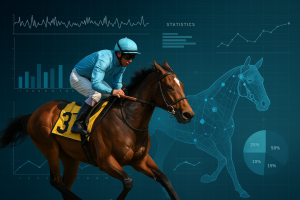Betting by Algorithm: The Rise of the Quant-Punter
Punters aren’t watching replays and guessing anymore — they’re running simulations. Using machine learning models that mimic racing conditions, some now input over 30 variables per race: jockey weight, track bias, last furlong velocity, even how a horse handles left-handed turns.
The sharpest bettors aren’t glued to bookmaker odds — they’re busy building their own. One such analyst from Melbourne publicly tracked 18% ROI over six months using nothing but code and discipline. For those who prefer a more casual — yet still tech-savvy — entry, crypto-enabled platforms offering features like a 7bit casino first deposit bonus blend intuitive UI with integrated analytics. It’s not just about gambling — it’s about edge.

Sensors in the Saddle: Data’s New Frontier
Trainers once read their horses like books — ears back meant stubbornness, twitching skin meant nerves. Now? Wearables stream live biometrics: stride cadence, muscle tension, oxygen efficiency. At one Sydney stable, a low-tier horse saw its career revived after data revealed it ran better in cooler climates. The team shipped him south and watched his rankings climb. Technology didn’t just tweak performance — it rewrote his trajectory.
Some stables are integrating AI to predict when a horse needs rest — not based on fatigue, but on blood lactate levels and sleep patterns. If that sounds futuristic, that’s because it is. And it’s happening now.
Trainers Torn Between Instinct and Intel
At Flemington, a veteran trainer famously dismissed analytics as “number voodoo” — until a young assistant showed him gait data that explained a gelding’s late-race fadeouts. Turns out, the horse overexerted in the first 400 meters. They tweaked the pace strategy. The result? A finish-line photo and an unexpected win.
This merging of intuition and numbers is not a replacement — it’s a recalibration. The old guard is learning to wield new weapons.
When Data Gets It Wrong
But let’s not turn horse racing into a spreadsheet just yet. Machines don’t account for a jockey’s hunger after three losses, or a horse’s mood after an overnight storm. Data can mislead, especially when correlation is confused with causation. Even platforms that champion data-driven approaches — like Katsubet Casino https://katsubetscasino.com/, which blends classic gaming with algorithmic design — know that numbers tell only part of the story.
One punter followed a model that favored front-runners at Rosehill — until the rail bias flipped mid-season due to new turf layering. He lost thousands before realising his model hadn’t been updated for track renovation.
The Digital Turf Ahead
Expect smart saddles embedded with pressure sensors, gait trackers stitched into horse blankets, and racetrack drones monitoring biomechanical efficiency from above. Trials are already underway in parts of Victoria where stable feeds are monitored not just for nutrition, but for patterns linked to behavioural shifts. Soon, a horse’s training cycle could be determined not by routine, but by AI-generated models predicting peak mental readiness.
For punters, the future is equally data-rich. Envision subscribing to real-time biometric feeds: heart rate dips before a sprint, sweat salinity levels, or even micro-changes in hoof strike symmetry. Wagering platforms might soon integrate predictive alerts, notifying users when a horse’s pre-race data matches a historically profitable pattern. With decentralised platforms and crypto betting growing — including those offering perks like the 7bit casino https://7bitcasino8au.com/ — the line between trader and punter continues to blur. This isn’t just about watching races. It’s about reading them before they unfold.
What Data Really Looks Like in Today’s Racing
| Metric | What It Tells You | Why It Matters |
| Stride Cadence | Rhythm and speed of the horse’s gait | Optimizing pace for each segment of a race |
| Lactate Threshold | When muscle fatigue begins to affect performance | Scheduling rest before decline impacts results |
| Sleep Patterns | Recovery quality and mental readiness | Timing peak-performance windows |
| Body Temperature Trends | Response to heat and environmental stress | Choosing race locations or times (as in the Sydney case) |
| Hoof Strike Symmetry | Balance and potential injury risk | Preventing long-term strain before symptoms emerge |
These aren’t just numbers — they’re quiet signals that used to go unnoticed, now surfaced in real time. Trainers can act earlier. Punters can bet smarter. And horses? They’re understood more deeply than ever before.
Final Stretch
Australia’s racecourses are becoming testbeds for the fusion of biology, technology, and raw instinct. The smartest trainers blend data with feel. The best punters balance models with experience. And the future of the sport? It belongs to those who can do both.
Horse racing is no longer just a gamble — it’s a game of information. And the odds favour the informed.
